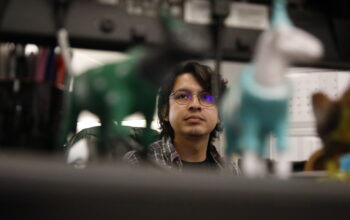Everyday students walks through the Botanical Garden at Pierce College, but how may of them know what it takes to create and maintain such an amazing spectacle?
It takes one man 20-hours per week to maintain the garden. Pulling weeds and cleaning trash out of the garden are some of the more time consuming tasks according to Keith Peabody instructional assistant of Horticulture.
The Botanical Garden is a Mediterranean Garden that was created in 2002. The many different species of plants all come from the five Mediterranean areas of the world, Southwestern Europe, Australia, South Africa, Chile and California
There is a lot of life inside the Botanical Garden aside from just the plant life. There are an unknown number of animal species as well according to Peabody.
Recently a Great Egret has been seen in the pond area. This bird is said to appear in areas where a new diverse ecosystem has formed.
This beautiful white bird can be seen often swimming in the pond with the ducks and other animals.
“It’s hard to tell what is here especially since it’s not all natural,” said Peabody. “People have been dumping animals here so they are not new wildlife but abandoned.”
They’re turtles and ducks as well as swans living in the pond inside the garden. And a rabbit is on the loose causing havoc by digging holes and eating plants according to Peabody.
The S.Mark Taper Foundation Life Science Botanic Garden was named after its main contributor.
The S.Mark Taper Foundation is known for making donations to deserving organizations in California. The foundation is previously known for making contributions to community development, arts programs, environmental services, as well as gay rights, health and human services.
The idea, which spawned in 1999 when it was realized that the area outside the former life science building would be a great place for a planter to demonstrate native plants, grew to incorporate the entire two-acre square of lawn formerly known as “The Quad.”
Dr. James Rikel, Kate Kubach and Pat Farris who continued to corroborate with each other until Rikel and Kubach both retired in June of this year started the garden.
“The reason it looks so nice is because a lot of people took the time to make sure it got the care it needed,” said Farris Instructor of life science and the head of the Botanical Garden. “We were out there with jack hammers when we first went to plant the soil was so terrible, but everything is doing pretty good now.”
The official groundbreaking took place on March 15, 2002. And planting began in Sept. 2003.
“The budget is peace meal we get things when we need things done,” said Farris. “So we don’t really have a working budget so far.”
Most of the funding comes from the school. With the exceptions being donations of plants and other supplies from the community and other private organizations according to Farris.
“It is a central location for the campus,” said Farris. “So I think the school wants to maintain it and make it look nice.”
The garden includes dozens of different plant species and well as a natural stone amphitheater that actually serves as an outdoor classroom. Also includes shade structures a sculpture fountain, and an “Evolution Walk”.
The sculpture fountain located near the pond at Vantage point three is an eight-foot high granite stone from southern Utah that weighs about two tons. The fountain was erected in memory of Jeff Smallwood a former life science instructor who died of AIDS.
The evolution walk is displayed using imprints of fossils in the ground on the main path that leads through the middle of the garden. Each part of the pathway shows major time periods of life’s history with fossils of each era.
“I think people don’t appreciate the succulence at first,” said Farris. “But the more time you spend out there the more people appreciate it.”
The Botanical Garden is a nice quiet place on campus where students came escape from the noise of the Mall area according to Farris.
“I come here (to the Botanical Garden) to study all the time,” said Sarah Masters a 20-year-old philosophy major. “It really is a peaceful atmosphere.”
A lot of worth while time is spent in the upkeep of the garden according to Peabody.
“I like the fact that this used to be a lawn that no one was ever at,” said Farris. “And now it’s used all the time. I used to have an office near by and at seven in the morning someone is sitting at every bench.”
Jim was one of the first English teachersto teach international students at ELS Language Center when it opened Feb. 2008 on California Lutheran College’s campus.
When students and faculty learned the news of his death, they were shocked.
“I still can’t believe it,” said Jaime Haile, who is an Academic Director at ELS. “He was one of the first teachers here and now he’s gone. The faculty still talks about how it’s weird how he’s not around anymore.”
Haile remembers the day when she had to tell the news to his students and continue teaching his lessons.
Though silent throughout the lecture, Jim’s students wrote to Lulu letting her know that her husband would be greatly missed.
The widow is currently preparing for her husband’s memorial service that will be held from 3 p.m. until 5 p.m. in Lundring Events Center of CLU on Nov. 20. She continues to teach her class every Tuesday at Pierce and dedicates her courage to Jim.
“It’s a miracle for me to be here today. I didn’t realize how important he was to me until he was gone,” she said.
—
acampbell.roundupnews@gmail.com



